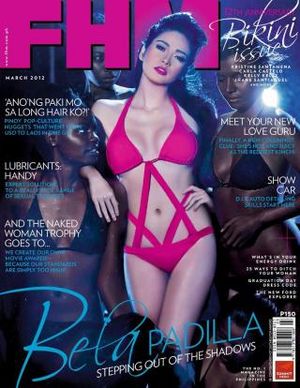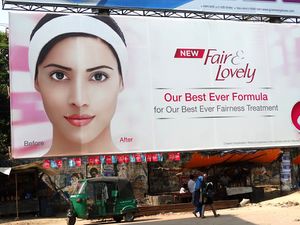Colourism in the Philippines
Colourism [1] refers to the discrimination of individuals with darker skin tones and preference given to those with lighter or 'whiter' skin, known as mestizos. [2] Mestizo originally meant those who were mixed race, usually Filipino and European, but the word now generally refers to those who are fairer-skinned. [3] The opposite of mestizos are known as morenos, which refers to people with dark hair and brown skin. [4] Specifically, the shade of a person's skin is closely tied with beauty and ranking in the Philippines, with a billion dollar industry surrounding beauty products that whiten the skin. The preference of fair skin in the Philippines has made colourism a predominant issue, especially since majority of Filipinos are born with darker skin. [5]
The Philippines is located in Southeast, with approximately a population of 100 million people, making it the 8th most populated country in Southeast Asia. [6] The Phillipines has a long history of colonization and it's effects are still apparent today. The influence of the Spanish and Americans helped establish this idea of fair skin superiority.
Colourism is not to be confused with racism, [7] which is the discrimination based on a person's race. A person's race encompasses their skin colour, as well as the beliefs and assumptions tied to that race. [8] Colourism is based solely on the skin tone of an individual. While racism is predominantly thought to be between races, colourism often exists within races.
Impact of Colonialism
The colonial argument refers to how colourism emerged as a result of colonialism. Fairness was attributed to the elite because manual labourers would get dark since they were in the sun all day while the elite had the luxury of staying indoors, shielded from the sun. Hence, skin colour became an indicator of socioeconomic status. [9] Colonialism also plays a role in colourism in that the colonizers were lighter skinned than the native Filipinos and were constantly upheld in positions of power. Colonialism plays a large role in the development of colourism because of how long the Philippines was colonized for, never giving the country a chance to develop it's identity. It was colonized from 1521 to 1946 by the Spanish, Americans and the Japanese. [10] As a result, some people feel as though they have not gotten the chance to understand accept what it means to be a darker skinned Filipino and have that as apart of their identity. [11] This has been called the "Filipino Inferiority Complex," where Filipinos feel ashamed of their race due to their colonial history, which has impacts to the present day. [12]
Spain
The Spaniards colonized the Philippines for three centuries from 1521 to 1898, motivated by the "spice trade, access to the markets of China, and the possibility of converting souls to Catholicism,"[13] which in that time Filipinos began to become "second-class citizens in their own country."[14] The Spanish set up their first permanent settlement, which is now the capital city of the Philippines, Manila. The colonization of the Philippines was considered a limited success because the country did not have the spices or goods that they were looking for. Instead, it became a gathering hub, with the Spanish prioritizing Chinese goods instead. [15]
Before the Spanish came in, the Philippines and China had strong trade relationships, with a small population of Chinese people living in the Philippines. When the Spanish came, they saw the importance of Chinese to the Filipino economy because they were the ones supplying luxury goods, while Filipinos could not. [16] On top of that, the Chinese performed laborious acts that the Spanish did not want to do and the Filipinos could not do. As a result of the strength of the Chinese economic influence, the Spanish began to favour the Chinese over the Filipinos, despite being in the Philippines. The Spanish were the wealthy elites at the top, the Chinese began to emerge as a strong middle class and indigenous Filipinos as the "bottom rung of the social hierarchy."[17]
Both Spanish and Chinese skin tone tends to be lighter than Filipinos, reinforcing the skin colour hierarchy in the Philippines. During this period of colonization, skin tone was associated with economic worth, which the Chinese seemed to have.
United States
The United States colonized the Philippines after defeating Spain during the Spanish-American war in 1898. [18] The Philippines was the ideal location for the US to build their military, which was their primary objective. During their rule, the Americans viewed themselves as a benevolent ruler, bringing law into a lawless land. They stripped the Philippines of all native culture and replaced it with the American way of life. Traditional practices were discouraged, an American school system was introduced, and English became the dominant language. [19] They also introduced legislature, like the Brigandage Act, which prohibited Filipinos from joining any organization that resisted America's rule. [20] During this time however, Filipinos were not treated with benevolence. They were often ridiculed and oppressed by the Americans, which ties into how the "Filipino Inferiority Complex" developed.
Filipinos were viewed as "savages" that needed the Americans help to become "civil," creating a dependency on them. The forced assimilation put the fair skinned Americans as the superior group and relatively darker skinned Filipinos as the subordinates. Naturally, Filipinos began to see the Americans as the ideal, from their skin tone to their ability to speak English.
Colourism and Everyday Life
Religion
Catholicism is the dominant religion in the Philippines, brought by the Spaniards in the 1700s. It is now the only Asian country where majority of the population is Catholic. When the Spanish came to colonize the Philippines, one of their main objectives was to convert Filipinos to Catholicism and due to the lack or organized religion in the Philippines, it proved to be successful.[21] Religion plays a role in establishing colourism because the historical figures of Jesus, Sto. Niño, and Mama Mary that are worshipped in church look like Caucasians, further reinforcing the nobility of fair skin. [22] The depiction of Jesus Christ is commonly white and as a central figure in the Catholic religion, Filipinos see this holy figure as something that they should aspire to be. Psychologically, this not only means his good behaviour but also his appearance. [23]
Media
In media campaigns and advertising, mixed race people are often favoured. Advertisers are hoping that the racial ambiguity will make them more relatable and appeal to a wider range of people but a secondary result is that it normalizes fair skin and Western features. [24] As a result, those who are mixed race in the Philippines are seen as more desirable, giving it social implications. Furthermore, being a mixed race Filipino also implies that you are more likely to have Western features -- lighter skin, bigger eyes, and a pointy noise, reinforcing that lighter skin is better.
FHM Magazine
A popular Filipino magazine, FHM by Summit Media, released a cover with a fair skin Filipina, Bela Padilla, emerging from a group of dark skinned women, captioned "Stepping out of the Shadows." [25] The magazine faced extreme criticism, with some saying that equating darkness with dark skinned women is colourism at it's extreme. Bela, a fair skinned Filipino model, is viewed as the "light" and "pure." Magazines like these exacerbates the problem of colourism in the Phillippines.[26] The magazine was later pulled and Summit Media apologized. They released a new cover months later. [27]
#MagandangMorenx
MagandangMorenx was a Twitter campaign, started by actress Asia Jackson. Asia Jackson is a half black, half Filipino American acctresss who wanted to "start a social conversation challenging whitewashed beauty standards." [28] The hashtag was based on the phrase "magandang moreno/a," which translates to beautiful brown skin. [29] She got her followers to post selfies with that hashtag and the movement grew to Europe, Asia, and America. [30] Movements like these are slowly becoming more and more popular as people want to develop better Filipino pride and get over the "Filipino Inferiority Complex."
Beauty products
The skin whitening or brightening industry is a $10 billion industry, with one in two Filipino women saying they have tried it at least once. [31] These products come in the form of lotions, creams, body wash, or even chemical peels. Often, these products contain chemicals such as mercury, types of steroids, and hydroquinone which have extremely dangerous side effects including scarring, skin rashes, and increased blood pressure. [32] Some of these products have been banned around the world and despite knowing these health effects, the industry still continues to grow.
The success of the skin whitening industry illustrates the problem of colourism. People are going to extreme measures to change their natural appearance, often risking serious health conditions. On the other hand, it also worsens to the issue of colourism because it is a good that not everyone can afford. Only those with money have access to these whitening products, which reinforce that if you are able to attain lighter skin, you are considered superior. Furthermore, these skin whitening products are becoming the norm, which normalizes that light skin is better.
Additional Resources
- Colonial Faces: Beauty and Skin Colour Hierarchy in the Philippines and US by Joanne Rondilla [33]
- Colonialism's continuing influence: Colorism in the Philippines by Monica [34]
- My Family's Slave by Alex Tizon [35]
- People Told Us About What It's Like Dealing with Colourism by Ebony-Renee Baker [36]
- Is Lighter Better?: Skin-Tone Discrimination among Asian Americans by Joanne Rondilla and Paul Spickard [37]
- The Difference Between Racism and Colorism by Lori L. Tharps [38]
References
- ↑ https://en.wikipedia.org/wiki/Discrimination_based_on_skin_color
- ↑ https://en.wikipedia.org/wiki/Mestizo
- ↑ http://www.gmanetwork.com/news/lifestyle/artandculture/267061/the-semantics-of-mestizo/story/
- ↑ http://www.11andmore.com/colonialisms-continuing-influence-colourism-in-the-philippines/#.WXzJwxPys_U
- ↑ http://www.filipiknow.net/filipino-obsession-white-skin/
- ↑ https://en.wikipedia.org/wiki/Philippines
- ↑ https://en.wikipedia.org/wiki/Racism
- ↑ https://en.wikipedia.org/wiki/Discrimination_based_on_skin_color
- ↑ https://japansociology.com/2013/10/25/colourism-in-the-philippines-behind-the-veil-of-whiteness/
- ↑ https://en.wikipedia.org/wiki/History_of_the_Philippines)
- ↑ http://digitalassets.lib.berkeley.edu/etd/ucb/text/Rondilla_berkeley_0028E_12807.pdf
- ↑ http://www.getrealphilippines.com/blog/2017/01/pinoy-inferiority-complex/
- ↑ http://epicworldhistory.blogspot.ca/2012/05/spanish-colonization-of-philippines.html
- ↑ http://www.filipiknow.net/filipino-obsession-white-skin/
- ↑ http://epicworldhistory.blogspot.ca/2012/05/spanish-colonization-of-philippines.html
- ↑ http://digitalassets.lib.berkeley.edu/etd/ucb/text/Rondilla_berkeley_0028E_12807.pdf
- ↑ http://digitalassets.lib.berkeley.edu/etd/ucb/text/Rondilla_berkeley_0028E_12807.pdf
- ↑ https://en.wikipedia.org/wiki/Spanish%E2%80%93American_War
- ↑ http://digitalassets.lib.berkeley.edu/etd/ucb/text/Rondilla_berkeley_0028E_12807.pdf
- ↑ http://en.wikipilipinas.org/index.php/Brigandage_Act
- ↑ http://epicworldhistory.blogspot.ca/2012/05/spanish-colonization-of-philippines.html
- ↑ http://www.filipiknow.net/filipino-obsession-white-skin/
- ↑ file:///Users/elisemance/Downloads/1358-5088-1-PB%20(2).pdf
- ↑ http://digitalassets.lib.berkeley.edu/etd/ucb/text/Rondilla_berkeley_0028E_12807.pdf
- ↑ https://rendezvous.blogs.nytimes.com/2012/02/28/filipinos-debate-racism-in-a-mens-magazine/
- ↑ https://rendezvous.blogs.nytimes.com/2012/02/28/filipinos-debate-racism-in-a-mens-magazine/
- ↑ https://rendezvous.blogs.nytimes.com/2012/02/28/filipinos-debate-racism-in-a-mens-magazine/
- ↑ http://www.nbcnews.com/news/asian-america/actress-asia-jackson-wants-take-colorism-redefine-filipino-beauty-n766431
- ↑ http://www.nbcnews.com/news/asian-america/actress-asia-jackson-wants-take-colorism-redefine-filipino-beauty-n766431
- ↑ http://www.nbcnews.com/news/asian-america/actress-asia-jackson-wants-take-colorism-redefine-filipino-beauty-n766431
- ↑ file:///Users/elisemance/Downloads/1358-5088-1-PB%20(2).pdf
- ↑ file:///Users/elisemance/Downloads/1358-5088-1-PB%20(2).pdf
- ↑ http://digitalassets.lib.berkeley.edu/etd/ucb/text/Rondilla_berkeley_0028E_12807.pdf
- ↑ http://www.11andmore.com/colonialisms-continuing-influence-colourism-in-the-philippines/#.WY377RPys_U
- ↑ https://www.theatlantic.com/magazine/archive/2017/06/lolas-story/524490/
- ↑ https://www.vice.com/en_ca/article/5gqmmz/people-told-us-about-what-its-like-dealing-with-colourism
- ↑ https://www.amazon.ca/Lighter-Better-Skin-Tone-Discrimination-Americans/dp/0742554937
- ↑ http://time.com/4512430/colorism-in-america/


